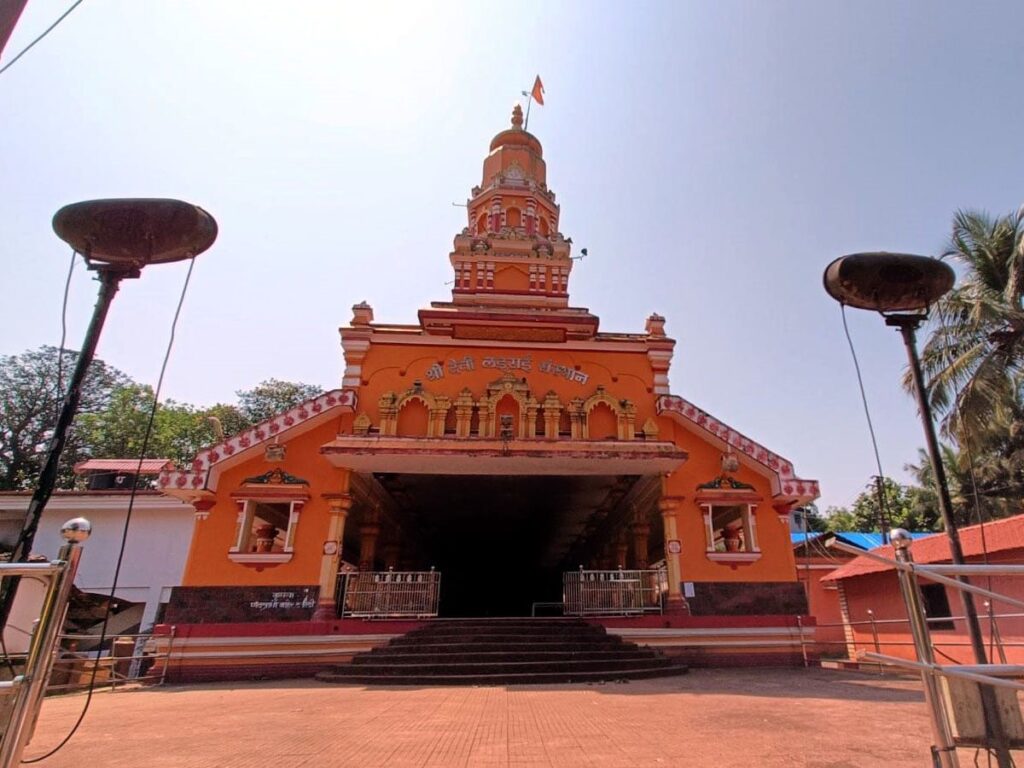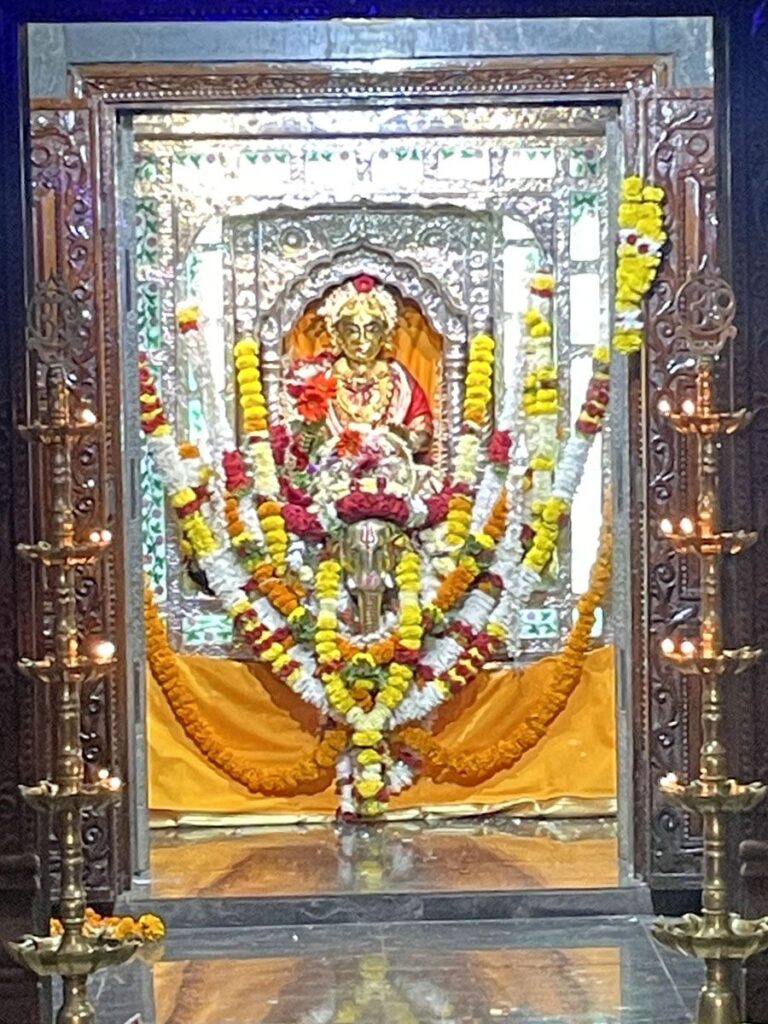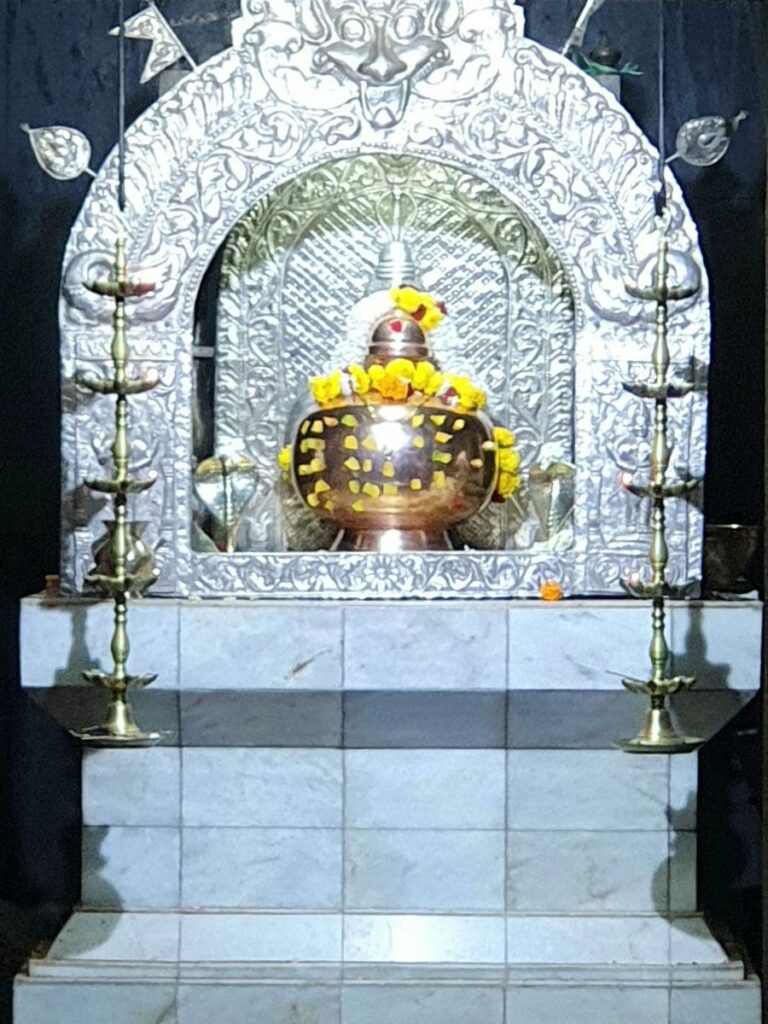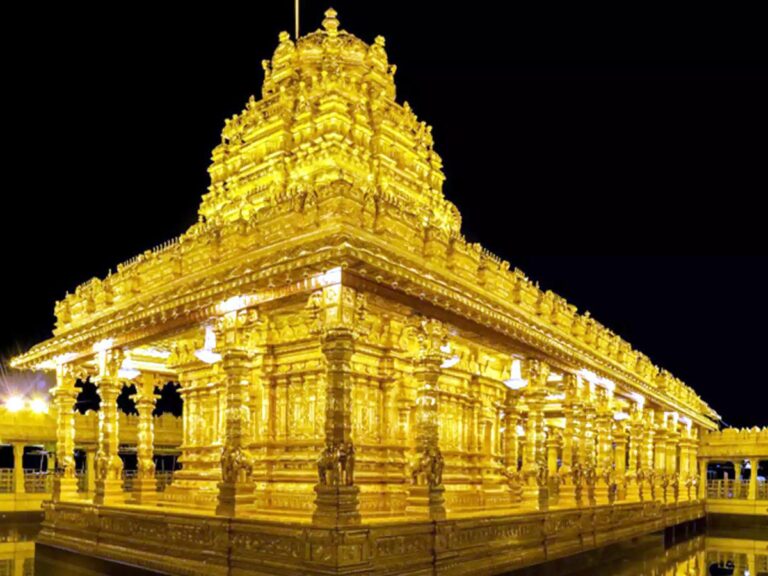Shree Lairaee Temple Goa | Shri Lairai Devi
The Shree Lairaee Temple is an ancient Hindu temple dedicated to the goddess Lairai Devi, located in the village of Shrigaon, North Goa, India. The temple is known for its unique architecture, blending northern and southern styles. It features a dome and a tall pyramid-like tower.

Contents
- 1 Shree Lairaee Temple History:
- 2 Legend of Shree Lairaee Temple:
- 3 Significance of Shree Lairaee Temple:
- 4 Myths & Beliefs of Shree Lairaee Temple:
- 5 Shree Lairaee Temple Timing & Rituals:
- 6 Places to visit near Shree Lairaee Temple:
- 7 FAQ:
- 8 How to reach Shree Lairaee Temple:
Shree Lairaee Temple History:
Ancient Origins: The temple has a long history, with roots believed to stretch back to ancient times, though the exact date of its establishment is unclear.
Goddess Lairai: Lairai is worshipped as a form of Shakti (the female principle of divine energy). She is highly revered by the local people, and her worship is deeply intertwined with local traditions and culture.
Folk Traditions: Shree Lairaee Temple is famous for its annual festival, known as “Shigmo” or “Shigmo Jatra,” a spring festival that involves vibrant processions and rituals. One of the most significant and dramatic rituals during this festival is the “Homkhand,” where devotees walk through a pit of burning coals, showcasing their devotion and faith in the goddess.
Read More>> Mahabodhi Temple Bodh Gaya

Legend of Shree Lairaee Temple:
The Seven Sisters: According to the legend, Goddess Lairai is one of the seven sisters, known as the Saptamatrikas, who are revered across the Konkan region. Each sister is believed to reside in different temples throughout the area.
Journey and Settlement: It is said that the seven sisters, including Lairai, left their original abode in search of a new place to reside. During their journey, each sister chose a different location to settle. Lairai chose Shirgao, and thus, Shree Lairaee Temple was established in her honor.
Protection and Power: Goddess Lairai is considered a powerful deity who protects her devotees and grants their wishes. She is also known for her fierce and benevolent aspects, embodying the dual nature of destruction and creation.
The Shigmo Jatra:
The Festival of Fire: The most famous legend associated with the temple is the ritual of the “Homkhand” during the Shigmo Jatra. According to the legend, this ritual symbolizes the divine power of Lairai and the unwavering faith of her devotees. It is believed that during the festival, the goddess blesses her devotees, allowing them to walk through the fire unharmed.
Devotees’ Faith: The story goes that the devotees who participate in the fire-walking ritual do so with complete faith in the goddess. They believe that Lairai’s divine protection will prevent any harm, showcasing their devotion and trust in her powers.
Cultural Integration: The festival and the legend reflect the deep cultural and religious integration within the local community. It is a time when the entire village and surrounding areas come together to celebrate, reinforcing social bonds and shared beliefs.
Read More>> Mahalakshmi Temple Kolhapur | Ambabai Temple

Significance of Shree Lairaee Temple:
Religious Significance: As a temple dedicated to Lairai Devi, it’s a sacred place for worship for Hindus, particularly in Goa. The annual Shrigao Jatra draws thousands of devotees seeking blessings and participating in unique rituals.
Historical Significance: Considered one of Goa’s oldest temples, it serves as a link to the region’s past. Its architectural style, blending North and South Indian influences, reflects Goa’s historical exposure to diverse cultures.
Cultural Significance: The Shrigao Jatra, particularly the fire walk, is a powerful cultural expression of faith and devotion. The tradition has been passed down through generations, showcasing the resilience of local customs.
Social Significance: Shree Lairaee Temple fosters a sense of community among devotees, especially during the Shrigao Jatra. It’s a time for people to come together, celebrate their faith, and strengthen social bonds.
Symbol of Religious Harmony: The tradition of exchanging offerings with the nearby Milagres Church, where Lairai Devi and Virgin Mary are seen as sisters, exemplifies Goa’s unique blend of Hinduism and Catholicism. The Shree Lairaee Temple stands as a testament to religious tolerance and peaceful coexistence.
Read More>> Arulmigu Sri Bannari Mariamman Temple

Myths & Beliefs of Shree Lairaee Temple:
Myths:
- Divine Origin:
- It is believed that Goddess Lairai descended from the heavens and chose Shirgao as her earthly abode. Her presence in the village is said to bring prosperity and protection to the inhabitants.
- Saptamatrikas:
- Lairai is considered one of the Saptamatrikas, or seven mother goddesses, each of whom has her own temple in the Konkan region. The myth states that these goddesses are sisters who dispersed across the land to protect different regions.
- The Eternal Flame:
- Legend has it that the sacred fire used during the Shigmo Jatra’s Homkhand ritual has been burning for centuries. This eternal flame is believed to be a direct manifestation of Goddess Lairai’s power and presence.
Beliefs:
- Healing Powers:
- Devotees believe that praying to Goddess Lairai can cure illnesses and bring about physical and spiritual healing. Many come to Shree Lairaee Temple seeking relief from ailments and suffering.
- Fulfillment of Wishes:
- It is a common belief that Goddess Lairai grants the wishes of those who worship her with a pure heart. People often come to the temple to seek blessings for personal and professional success.
- Protection from Evil:
- The goddess is seen as a powerful protector who wards off evil spirits and negative energies. Devotees believe that Lairai’s blessings can safeguard them from harm and misfortune.
- Fire-Walking Faith:
- During the Shigmo Jatra, the ritual of walking on hot coals is a testament to the devotees’ faith in Goddess Lairai. It is believed that those who walk through the fire unscathed are blessed and protected by the goddess.
- Purification Rituals:
- Many believe that participating in or witnessing the temple rituals, especially during festivals, purifies the soul and cleanses one’s sins. The Shigmo festival, in particular, is seen as a time of spiritual renewal and community bonding.
- Community Bonding:
- The temple serves as a focal point for community gatherings and social cohesion. It is believed that participating in temple activities strengthens communal ties and fosters a sense of unity and belonging.
Read More>> Khajuraho Temple: Beyond the Erotic Sculptures

Shree Lairaee Temple Timing & Rituals:
Temple Timings:
Shree Lairaee Temple is generally open to devotees throughout the day, but specific timings can vary. Typically, the temple timings are as follows:
- Morning: 6:00 AM to 12:00 PM
- Afternoon Break: 12:00 PM to 4:00 PM (temple may be closed for cleaning and maintenance)
- Evening: 4:00 PM to 8:00 PM
It is advisable to check the exact timings with local sources or temple authorities, especially during festivals when timings might extend.
Rituals:
- Daily Rituals:
- Aarti: Shree Lairaee Temple conducts daily aarti (ritual of worship) sessions in the morning and evening. This involves singing hymns and waving lamps before the deity.
- Abhishekam: Devotees perform abhishekam (ritual bathing of the deity) using milk, honey, water, and other sacred items.
- Weekly Rituals:
- Special Aarti: On certain days of the week, special aarti sessions are held, often attracting more devotees.
- Monthly Rituals:
- Full Moon and New Moon: Special prayers and rituals are conducted on full moon and new moon days, which are considered auspicious in Hindu tradition.
- Annual Rituals:
- Shigmo Jatra: The most significant annual festival is the Shigmo Jatra, celebrated in the spring. Key rituals during this festival include:
- Homkhand: A dramatic fire-walking ceremony where devotees walk over burning coals to demonstrate their faith and receive blessings from Goddess Lairai.
- Procession: A grand procession with the idol of Goddess Lairai taken around the village, accompanied by music, dance, and traditional performances.
- Special Poojas: Various special poojas (prayers) and havans (fire rituals) are performed to honor the goddess during this period.
- Shigmo Jatra: The most significant annual festival is the Shigmo Jatra, celebrated in the spring. Key rituals during this festival include:
- Special Poojas and Offerings:
- Navratri: During the nine nights of Navratri, Shree Lairaee Temple hosts special poojas and cultural events, celebrating the goddess in her various forms.
- Personal Poojas: Devotees can also book special poojas for personal milestones such as birthdays, anniversaries, or to seek specific blessings.
- Other Practices:
- Prasad Distribution: After the rituals, prasad (sacred food offering) is distributed to the devotees.
- Devotee Offerings: Devotees often bring flowers, coconuts, fruits, and other items to offer to the deity as a sign of their devotion.
Places to visit near Shree Lairaee Temple:
1. Bicholim
- Mayem Lake: A serene and picturesque lake perfect for boating and picnics.
- Arvalem Caves: Ancient rock-cut caves with significant historical and archaeological value.
- Arvalem Waterfall: A stunning waterfall located near the Arvalem Caves, especially beautiful during the monsoon season.
2. Mapusa
- Mapusa Market: A bustling market known for its vibrant atmosphere and a variety of goods, including fresh produce, spices, textiles, and souvenirs.
- Bodgeshwar Temple: A popular temple dedicated to Lord Bodgeshwar, attracting many devotees.
3. Vagator
- Vagator Beach: A beautiful beach known for its dramatic cliffs, clean sands, and vibrant nightlife.
- Chapora Fort: An ancient fort offering panoramic views of the Arabian Sea and the surrounding areas.
4. Anjuna
- Anjuna Beach: Famous for its lively beach culture, flea market, and vibrant nightlife.
- Anjuna Flea Market: A colorful market held every Wednesday, offering a wide range of goods from clothing to jewelry and handicrafts.
5. Pernem
- Mandrem Beach: A tranquil beach ideal for a relaxed day by the sea.
- Ashwem Beach: Known for its calm and serene environment, perfect for unwinding.
6. Thivim
- St. Christopher Church: A historic church with beautiful architecture and a peaceful atmosphere.
7. Surla
- Surla Waterfall: A scenic and relatively lesser-known waterfall, perfect for nature lovers and hikers.
8. Sankhali (Sanquelim)
- Harvalem Rock Cut Caves: Also known as the Pandava Caves, these are ancient rock-cut caves dating back to the 6th century.
- Harvalem Waterfall: Near the caves, this waterfall is a refreshing spot for a visit, especially during the monsoon.
9. Calangute and Baga
- Calangute Beach: Known as the “Queen of Beaches,” it is one of the most popular tourist spots in Goa.
- Baga Beach: Adjacent to Calangute, Baga Beach is famous for its vibrant nightlife, water sports, and dining options.
10. Old Goa
- Basilica of Bom Jesus: A UNESCO World Heritage Site housing the relics of St. Francis Xavier.
- Se Cathedral: One of the largest churches in Asia, known for its impressive architecture.
FAQ:
1. Where is Shree Lairaee Temple located?
- Shree Lairaee Temple is located in the village of Shirgao in North Goa, India.
2. What are the temple timings?
- The typical timings are:
- Morning: 6:00 AM to 12:00 PM
- Afternoon Break: 12:00 PM to 4:00 PM
- Evening: 4:00 PM to 8:00 PM
- Note: Timings may vary, especially during festivals, so it’s advisable to check with local sources.
3. What is the significance of the temple?
- The temple is dedicated to Goddess Lairai, one of the seven sisters, or Saptamatrikas, revered in the Konkan region. It is known for its powerful spiritual aura and cultural importance.
4. What are the major festivals celebrated at the temple?
- The major festival is Shigmo Jatra, celebrated in the spring. It includes the famous Homkhand fire-walking ritual, grand processions, and various cultural performances.
5. What rituals are performed at the temple?
- Daily Rituals: Morning and evening aarti, abhishekam.
- Weekly Rituals: Special aarti sessions.
- Monthly Rituals: Special prayers on full moon and new moon days.
- Annual Rituals: Shigmo Jatra with fire-walking, processions, and special poojas.
6. Can special poojas be booked?
- Yes, devotees can book special poojas for personal milestones such as birthdays, anniversaries, or to seek specific blessings.
7. What are some nearby attractions?
- Nearby attractions include Mayem Lake, Arvalem Caves and Waterfall, Mapusa Market, Vagator Beach, Chapora Fort, and Anjuna Beach, among others.
8. Is there an entry fee to visit the temple?
- No, there is no entry fee to visit Shree Lairaee Temple. Donations are welcome and appreciated.
9. What facilities are available at the temple?
- Shree Lairaee Temple provides basic facilities such as drinking water, restrooms, and a prasad counter. During festivals, additional arrangements are made for devotees.
10. Are there any specific dress codes for visiting the temple?
- Visitors are expected to dress modestly and respectfully. Traditional Indian attire is preferred, and it is advisable to avoid shorts or revealing clothing.
11. How can I reach Shree Lairaee Temple?
- The temple is accessible by road. The nearest major town is Mapusa, which is well-connected by buses and taxis. The closest railway station is Thivim, and the nearest airport is Dabolim Airport in Goa.
12. What is the best time to visit the temple?
- Shree Lairaee Temple can be visited year-round, but the best time is during the Shigmo Jatra festival to experience the vibrant celebrations. The winter months (November to February) offer pleasant weather for sightseeing.
13. Can I take photographs inside the temple?
- Photography policies may vary. It is best to check with temple authorities before taking photographs inside the temple premises.
How to reach Shree Lairaee Temple:
By Air:
- Nearest Airport: The closest airport is Dabolim Airport (Goa International Airport), which is about 55 kilometers away from Shree Lairaee Temple.
- From the Airport: You can hire a taxi or rent a car from the airport to reach the temple. The drive takes approximately 1.5 to 2 hours.
By Train:
- Nearest Railway Station: Thivim Railway Station is the closest, around 18 kilometers away.
- From Thivim Station: You can take a taxi or auto-rickshaw from the station to the temple. The drive usually takes about 30 to 45 minutes.
By Bus:
- Local Buses: Goa has a good network of local buses operated by Kadamba Transport Corporation. You can take a bus from major towns like Mapusa, Panaji, or Bicholim to reach Shirgao.
- From Mapusa: Mapusa is around 24 kilometers from Shirgao. You can take a direct bus or a combination of buses to reach Shree Lairaee Temple.
- From Panaji: Panaji, the capital city, is about 37 kilometers from Shirgao. Buses are available from the main bus stand to Bicholim, from where you can get a local bus or taxi to Shirgao.












